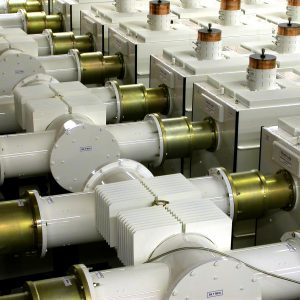Shively Labs
Balanced Combiners
Showing the single result
-

Balanced Combiner
For larger more complex sites, Shively Labs balanced combiner modules allow any number of stations to be combined into a common antenna. Systems have been designed to handle up to 21 analog stations, along with their digital counterparts. Frequency spacings as close as 0.8 MHz are routine, even on large systems. Shively’s unique design allows stations to be added in any frequency order without the need to reconfigure the existing combiner chain – making them ideal for sites where future expansion is planned.
All Shively Labs combiners use bandpass filtering, ensuring higher spectral purity, flat in-band frequency response, and typical isolation values of 50 dB or higher – even for frequencies spaced 0.8 MHz apart. All Shively Labs bandpass filters are iris coupled, eliminating the need to adjust the passband to compensate for the increased distortion and asymmetry inherent to older, loop coupled designs.
Balanced combiners are generally used for combiner systems of four or more stations, for systems designed to feed two outputs, or for systems where an auxiliary wideband input is desired. Balanced combiner systems commonly require more floor space than a branched or starpoint system, and are usually more expensive. Balanced combiner modules are also used to expand branched combiner systems from their original configuration.
A balanced combiner system consists of station-specific modules along with shared “system components” used in the broadband signal line. Typical system components are interconnecting coax between station modules, output dual directional couplers to facilitate test measurements and monitoring, power splitters and patching networks to split combined output signals between antenna halves, and dummy loads for wideband inputs when not in use as antenna feeds. Lockout/Tagout switches may be either station specific or a shared system component.
A station-specific balanced combiner module (right) consists of input hybrid, two four cavity or resonator bandpass filters, and an output hybrid. In addition, a low-level group delay equalizer is used when a station’s signal is within 1.0 MHz of any other signal in the combiner system.
